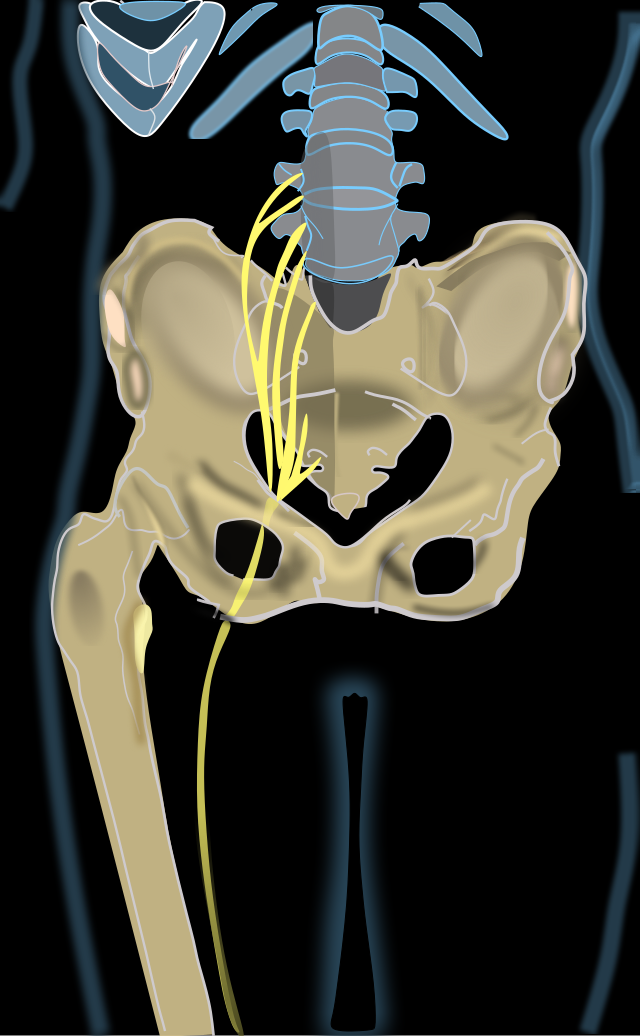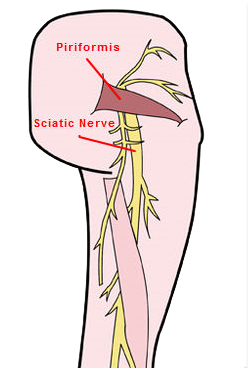How to heal piriformis syndrome quickly is all about our willingness to change. And we are not designed to change.
It is a fascinating problem.
You grip your butt. You might not think you do but you do.
Butt gripping, or overusing the gluteus maximus muscle, is something that gets in the way of healing piriformis syndrome quickly.
Relaxing your butt makes it easier to change your posture. Changing your posture in the way I suggest, relaxes the piriformis muscle and creates space for the sciatic nerve.
The sciatic nerve is the longest nerve in the body. It runs from the lower spine, all the way down to the foot.
The piriformis muscle is one of only three muscles connecting the legs to the spine. The gluteus maximus and psoas major are the other two.
Piriformis syndrome is the name given to the pain associated with the piriformis muscle pressing on the sciatic nerve.
Piriformis syndrome symptoms include a dull ache in your butt, shooting pain down the leg, and sometimes the foot going numb.

It can happen for a number of reasons. Poor posture shouldn’t ever be ruled out. A chronically tight piriformis muscle coupled with poor posture makes piriformis syndrome much more likely.
Walking with the feet turned out or simply walking badly can create an environment for piriformis syndrome.
How many hours a day do you sit? The likeliness of sciatic pain and piriformis syndrome increases with every hour you sit in a chair.
Sitting is bad. Very bad.
But back to the question at the top of this post.
With the help of simple piriformis syndrome
exercises and easy changes to your posture and walking patterns, I will show you how to heal piriformis syndrome quickly.
My buttocks hurt when I sit!
Have you thought about the way that you sit?
How are you sitting right now?
Sitting is bad for a number of reasons but the position of our pelvis when we sit almost always impacts the sciatic nerve and piriformis muscle.
I would guess that right now, as you read this, your lower back is rounded back and your pelvis is tucked under like both people in the picture above.

It is how most people usually sit.
And it is crazy is how many people get away with sitting terribly in this exact way.
I admit it is fair to wonder why some people go through life with poor posture and terrible movement patterns and don’t end up with aches, pains, and injuries.
Luck has something to do with it.
Some people can drink and smoke all their life and never pay a price. Sometimes there is no rhyme or reason to why things happen.
But essentially, piriformis syndrome sciatic nerve issues come down to a question of space.
Sciatica is pain associated with the sciatic nerve and how it flows through the lower back. This type of pain usually happens from the nerve touching a bone or disc.
Piriformis syndrome can be described as a butt spasm that gets in the way of the flow of the nerve through the pelvis.
“My butt hurts when I sit”, doesn’t always refer to piriformis syndrome but it is a good bet that the piriformis muscle is involved with whatever you are feeling.
So we come back to change.
Without making changes to the way you sit, why would you find relief from the debilitating pain that can shut down your life?
What exercises should I avoid with piriformis syndrome?

You shouldn’t live with pain.
Because living with pain it is not really living. It’s not living to your fullest.
Often we get little pains and think, “Oh, I’ll deal with it later.”
You can’t do that when your car gets a flat tire. You get it fixed or it’s not going anywhere.
How about your one and only body? It deserves that kind of constant tuning up.
But what kind of tune-up is available for pain in the butt that won’t go away?
Unfortunately, it is usually the wrong kind.
When I first started helping people with complicated pain issues I realized that there are certain pain problems that you can’t stretch your way out of.
I figured out that for many problems, sciatica and piriformis syndrome included, stretching seemed to be the main technique for getting out of pain.
To be honest, sometimes it works. A lot of the time even.
But what about when it doesn’t. What then?
We all experience pain and injury differently. Some people are more sensitive than others and sensitivity requires a different kind of care.
You know you are one of these sensitive people if you have followed the traditional path for how to heal piriformis syndrome quickly, and nothing has worked.
Doctor visits… Repeated trips to the physical therapist… Cortisone shots… Or even surgery.
These methods don’t help everyone, and if you are one of those people, it is so important to stop searching for a fix that isn’t available.
So if you have been doing classic piriformis stretches in search of relief that doesn’t come, it is time to take a step back and do less.
The picture on the left, a classic pose called pigeon, is one of a number of piriformis exercises to avoid.
In general, if you are finding that active stretches aren’t working, stop doing them. If they haven’t worked up until now, it is not likely that something will change.
The picture on the right is a different kind of exercise that relaxes the piriformis
muscle and stretches your hip flexor instead.
Getting out of piriformis pain is often as simple as learning out to let go when it comes to standing, walking, and exercising.
Is walking good for piriformis syndrome?

There is a difference between walking and walking well.
Walking well is good for piriformis syndrome so you won’t be surprised when I tell you that walking poorly is not going to help with chronic pain issues.
Walking successfully is one of the easiest avenues to how to heal piriformis syndrome quickly.
The crazy thing is we aren’t really designed to think about the way we walk and if you aren’t in pain, there is no immediate reason to change your walk.
Though going through life with pain in the buttocks is a very good reason to make some simple and basic changes to your movement patterns.
There is a design to how we should move. The feet are supposed to fall in a certain way. The arms and legs are meant to alternate with each step.
If and when these things happen you are much less likely to have butt muscle pain. But these things don’t often happen.
Instead, you walk like the guy in the picture on the left and experience the piriformis syndrome
pain pattern that your brain begins to accept as normal.
Here are two ways to know if you are walking like the guy in the picture on the left.
Do your feet turn out when you walk?
Do your shoes wear out on the outsides of the soles?
If the answer is yes, to either or both, you are more likely to experience pain in buttocks when walking and suffer the ill effects of sciatic pain and piriformis syndrome.
But all is not lost.
Relax your butt when walking in the same way as standing and you start to relax the piriformis and create more space for the sciatic nerve to flow without pain.
How to treat piriformis syndrome?

These are the three most important lessons to learn when trying to figure out how to heal piriformis syndrome quickly.
Traditional methods of healing often call for action such as physical therapy, pain medication, or even surgery.
And just like I said at the start of this post, these methods are tried and true for most people.
But if you are not like most people, and these traditional methods have led to you running on a hamster wheel of doctor’s visits, physical therapy, and other interventions, it might be time to think about a different approach.
And that approach is… Less is More.
Do less to achieve more.
1
Change
2
Relax
3
Release
A return to the active lifestyle of your dreams is possible, but if you have found that nothing seems to be helping you no matter how hard you try, you might be trying too hard.
Nerve and muscle issues like sciatica and piriformis syndrome can take hold of your life and not let go.
And when they take hold they can drag you down into a sea of depression and despair.
But all is not lost if you are willing to consider an alternative approach that might actually be easier than everything else you have tried.
Learning to relax and following my simple prompts to change the way you walk, stand and exercise, might just be the solution you have been looking for in the search for how to heal piriformis syndrome quickly.
